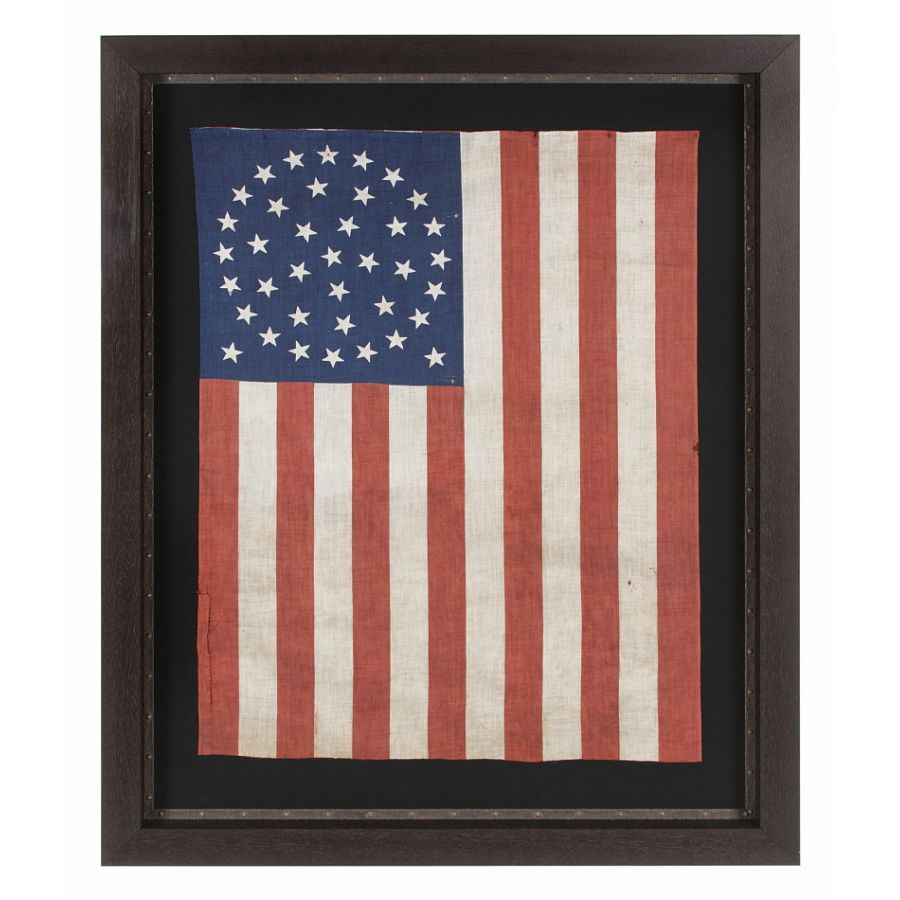
| |
38 STARS IN A MEDALLION CONFIGURATION WITH 2 OUTLIERS, A RARE EXAMPLE OF THIS PATTERN ON A LARGE SCALE PARADE FLAG WITH RED STRIPES, 1876-1889, COLORADO STATEHOOD |
|
| Available: |
Sold |
| Frame Size (H x L): |
41.5" x 33.75" |
| Flag Size (H x L): |
31.75" x 24.75" |
|
| Description....: |
|
38 star American parade flag, printed on plain weave cotton. The stars are arranged in a triple-wreath form of the medallion configuration, with a single center star and two stars flanking outside the basic pattern toward the fly end. Typically there are 4 flanking stars outside this type of pattern, one in each corner. The inclusion of only two was done intentionally to leave room for the easy addition of two more states. Flag-makers felt that more Western Territories were soon to be added to the Union and eagerly anticipated their arrival. This was popular in 38 star parade flags but is rarely ever seen in other star counts.
One of the most notable features on this particular example is the color of its stripes. Most parade flags in this star count have red stripes that lean heavily toward orange and have a chromatic luster. That was common across many printed flags made between the 1850's and the 38 star period, phasing out in the last decade of the 19th century. This flag has strong colors, including a rich, royal blue canton and deep red stripes, slightly oxidized and faded with russet overtones.
Note also how the square profile of the canton and the somewhat square proportions of the flag itself contribute to its interesting presentation. This is a very rare example in a bold, large size. When these factors are added to its circular star pattern and great colors, the result is an excellent flag of the centennial era.
Colorado became the 38th state on August 1st, 1876. This was the year of our nation’s 100-year anniversary of independence. Per the Third Flag Act of 1818, stars were not officially added until the 4th of July following a state's addition. For this reason, 37 was the official star count for the American flag in 1876. Flag-making was a competitive venture, however, and few flag-makers would have been continuing to produce 37 star flags when their competitors were making 38’s. It is for this reason that 38 and 13 stars (to represent the original 13 colonies) are more often seen at the Centennial International Exposition, the six-month long World’s Fair held in Philadelphia in honor of the event. Some flag-makers would have been adding a star for the 38th state even before it entered the Union, in the early part of 1876 or even prior. In fact, many makers of parade flags were actually producing 39 star flags, in hopeful anticipation of the addition of two more Western Territories instead of one. But the 39th state would not join the Union for another 13 years, when the Dakota Territory entered as two states on the same day. The 38 star flag became official on July 4th, 1877 and was generally used until the addition of the Dakotas in 1889.
President Ulysses S. Grant was in office when the first 38 star flags would have appeared. The list of presidents serving during the period when the 38 star flag was actually official include Rutherford B. Hayes, James Garfield, Chester Arthur, Grover Cleveland, and Benjamin Harrison.
Mounting: The flag has been placed in its correct vertical position, with its canton in the upper left. It has been hand-stitched to a background of 100% cotton, black in color, which was washed to reduce excess dye. An acid-free agent was added to the wash to further set the dye and the fabric was heat-treated for the same purpose. The mount was then placed in a substantial Italian molding with grain and coloration like dark walnut, to which a liner was added that is constructed of wood but has a beautiful metallic finish that presents like antique iron with rusted nail heads. The glazing is U.V. protective acrylic.
Condition: There is an L-shaped tear in the top red stripe. This was stabilized during the mounting process. There are some tiny, scattered rust stains and tiny bleach spots. There are minor tack holes along the hoist where the flag was once affixed to a wooden staff. Many of my clients prefer early flags to show their age and evidence of use. |
|
|
|
| Collector Level: |
Advanced Collectors and the Person with Everything |
|
| Flag Type: |
Parade flag |
|
| Star Count: |
38 |
|
| Earliest Date of Origin: |
1876 |
|
| Latest Date of Origin: |
1889 |
|
| State/Affiliation: |
California |
|
| War Association: |
1866-1890 Indian Wars |
|
| Price: |
SOLD |
|
| |
Views: 3471 |
|
|
|

